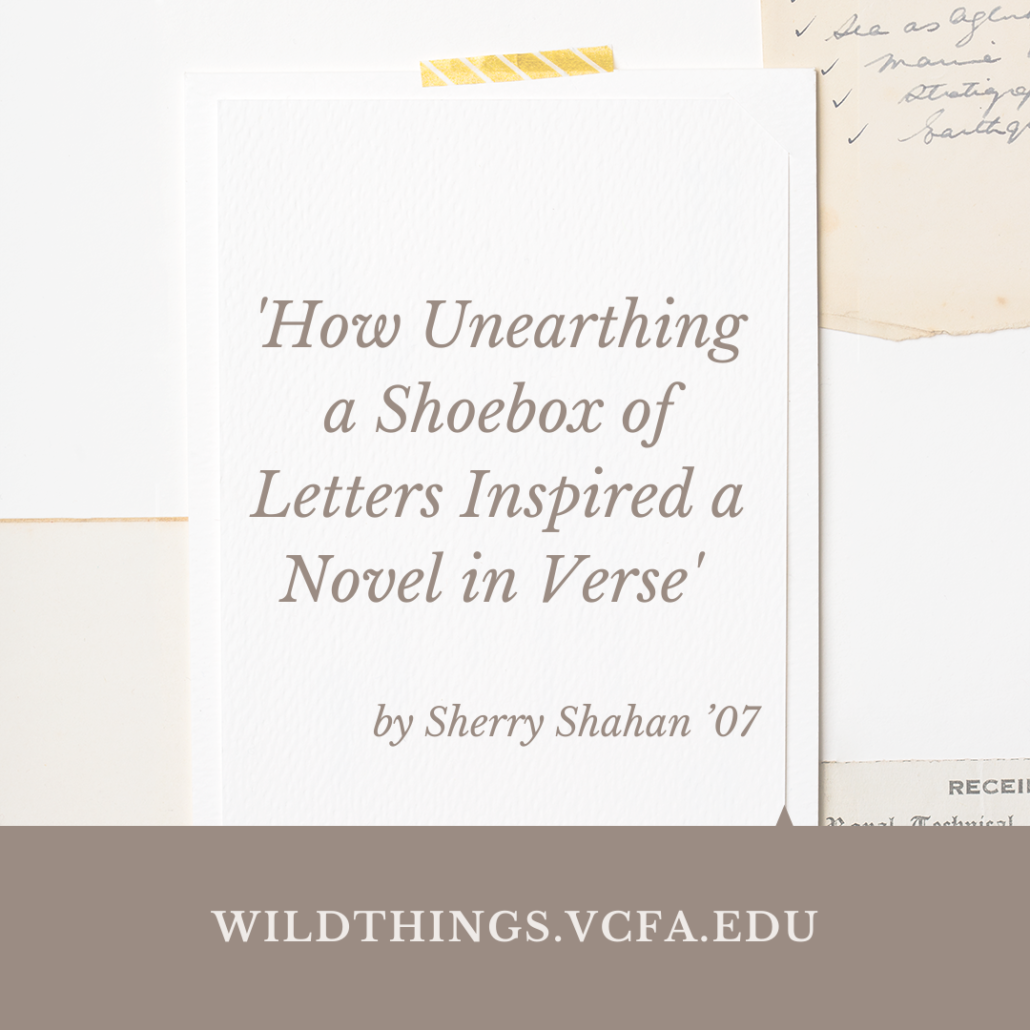‘How Unearthing a Shoebox of Letters Inspired a Novel in Verse’ – Sherry Shahan ’07
While cleaning out my office I found a shoebox filled with letters from a friend who served in Vietnam during the tumultuous 1960s. I spent hours pouring through his honest and heart-wrenching accounts of the twenty-year war. I knew I had to do something with his letters; I’d kept them more than fifty years.
Late afternoon shadows fell while I arranged letters according to dates stamped on the red-white-and-blue tinged envelopes. Excerpt:
I’m lying on an army cot at my outpost. Every breath, I suck in a battalion of bugs. Damn insects. It’s raining and they decided to come in here where it’s dry. Last night I about got plugged writing a letter using this same flashlight. (sic) A sniper saw it. That would be a helluva way to sign off—with a big glob of guts.
Since letters inspired Purple Daze: A Far Out Trip, 1965 it made sense to incorporate journal entries, notes, and letters into the narrative. I spent weeks writing sketches about my high school friends, our underage drinking, perpetual pot smoking, and adrenaline-addled antics. Memories assaulted me twenty-four-seven. Most were unclouded, fully formed. Human history and delinquent deeds.
Once I started scribbling I couldn’t stop. The story felt truest when told in short, energetic bursts—scenes that captured a single moment, whether an emotion or idea. I filled legal pads, doodled in margins. The material was a steamroller, either too much or nothing at all.
Four-by-five index cards cluttered the floor of my office. I studied them, rearranged them, and settled inside every highly charged emotional moment. I’d never before used cards as an organizational tool, in part because I’d never before experimented with a hybrid form of storytelling.
I studied the groundbreaking classic on war and memory, The Things They Carried by Tim O’Brien. Since my principal characters were teens I read dozens of YA novels in verse: critically acclaimed Out of the Dust by Karen Hess, True Believer by Virginia Euwer Wolf, Keesha’ House by Helen Frost, even River Spoon Anthology by Edgar Lee Masters, originally published in 1915.
Since Ron Koertge writes both traditional narrative prose and novels in verse, I asked him about his choice for Brimstone Journal, a story related in a series of first-person accounts written in short poetic monologues and dialogues.
He said, “Brimstone kind of imposed itself on me, and it was free verse right out of the gate. I never even considered writing it in margin-to-margin prose. There was always something punchy and immediate about the poems.”
Experimenting with a nontraditional form came with challenges. Each of my six viewpoint characters required his or her own story arc, while they struggled with highly charged emotional issues: war, riots, adolescent sex, family alcoholism, etc.
Yet their individual tales had to be interlaced into the whole. Demanding, yes. But the approach seemed the best way to give readers access into the characters’ private worlds.
I became hyper-aware of ‘white space’ and its role in shaping emotions. In certain instances, white space can reflect the power of a thought or idea in a way that margin-to-margin text cannot.
Since Purple Daze is character driven, the landscape of the mind is more important than physical setting. Although much of the story takes place in high school I rarely describe the campus. I felt there was less need for physical description because what my characters think and feel is more powerful than their appearance. And equally, their attitudes, beliefs, and sensitivities.
This piece is only four lines and incorporates condensed metaphoric language:
Love is like sticking
your car keys in a pocket with
your sunglasses and thinking
your glasses won’t get scratched.
Another example:
My motel sign:
VACANCY
I hope these prose poems take readers to a new level of understanding of the characters and how they view their place in the world. I’ve heard poets compare white space to the negative space in a painting—space that makes an object in a picture more prominent. The more negative space, the more the object stands out.
Ellen Hopkins, author of bestselling verse novel Crank believes verse novels should use: “startling imagery and elevated language, such as metaphor, alliteration, assonance, which appeal—often subconsciously—aesthetically to the reader.” Writing poetry, she adds, allows her to “climb more deeply inside a character’s head.”
In later drafts, I added historical accounts from 1965, such as the United States’ authorization of Napalm, the assassination of Malcolm X, and the FBI’s all-out crusade to discredit Dr. Martin Luther King, Jr. These pieces are juxtaposed against musical references: rock concerts and the story behind Arlo Guthrie’s talking blues song “Alice’s Restaurant.”
ALICE’S RESTAURANT
- 1964. Alice and Ray Brock purchase a gothic revival building in Great Barrington, Massachusetts. The small, pine church is transformed into a refuge, where young people escape establishment pressures and the hell of Vietnam.
Agitated neighbors shout at the long-haired, nonconformists living in this beatnik commune.
Thanksgiving 1965. Arlo Guthrie, son of folk singer Woody Guthrie, and a friend haul garbage from Brock’s home to the city dump. Discovering it closed for Thanksgiving, they toss the trash down the hill.
The pair is arrested, appearing before a blind judge, who’s unable to see the 8 x 10 glossy photos in evidence. They plead guilty, pay a $25 fine, and clean up the mess.
“Alice’s Restaurant Massacree” evolves into a sardonic 18-minue talk-song that records the events. Later, lyrics critical of the war are woven in.
I sometimes wonder if the popularity of novels in verse is a trend? Or is it possible that they can do something traditional prose novels can’t? Is the form, in fact, suited to the turbulent, but often-secret inner lives of multiple characters presented in first person?
Writers have asked me when it’s appropriate to consider this unique structure.
-
Stories that are better told from more one than one point of view. Mel Glenn’s verse novel Who Killed Mr. Chippendale? has more than fifty viewpoint characters. Even if Glenn had used an omniscient pov, bouncing in an out of so many heads could be confusing. That said, not all novels in verse have more than one close first person character.
-
Stories that are predominantly character driven, as opposed to action-driven. Verse novels tend to deal with highly charged emotional issues, such as incest (Furniture by Thalia Chaltas), mental illness (Stop Pretending What Happened When My Big Sister Went Crazy by Sonya Sones), teen pregnancy (First Part Last by Angela Johnson).
-
Stories with poetry as a subplot or theme. In Locomotion, Jacqueline Woodson’s main character is exploring poetic forms to help him deal with the untimely death of his parents. In Koertge’s Shakespeare Bats Clean Up the main character is a bedridden, bored kid who reads his dad’s poetry books. He then begins writing poems to express his frustrations.
-
Stories that are best told in short, energetic bursts – instead of traditional margin-to-margin prose. For example, scenes that capture a single moment whether it be an emotion or an idea.
Exercise: Take a paragraph from any work of fiction. Rewrite it in free verse.
Concentrate on metaphor, assonance, imagery, and cadence. Think about tone and how it relates to character. Shouldn’t all good writing contain these elements? Sure. But I find it easier to focus on ‘voice sounds’ and ‘patterns of expression’ when my writing looks like poetry.







